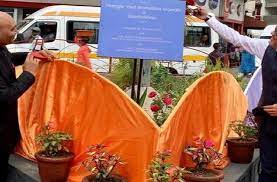22 Mar 2022 Mahatma Gandhi Green Triangle

Mahatma Gandhi Green Triangle – Today Current Affairs
- Recently Mahatma Gandhi Green Triangle has been unveiled in Madagascar to mark the elixir of independence.
Today Current Affairs
Key points
- The word green or green in the triangle or the triangle signifies their commitment to sustainable development and saving the environment.
- The purpose of naming this triangle as Mahatma Gandhi Green Triangle is to pay tribute to Mahatma Gandhi.
- Mahatma Gandhi was a ‘famous diaspora’ who returned to India from South Africa and led India’s freedom struggle and changed the lives of Indians forever.
- Madagascar is home to a large number of expatriates from the Indian state of Gujarat and Gandhiji was related to Porbandar in Gujarat state, so a Green Triangle in his name has been unveiled in the capital of Madagascar.
- Madagascar appreciated the efforts of the Embassy in greening the area, saying that this effort serves the purpose of the Urban Municipality of Antananarivo to maximize the green area in the capital Madagascar, according to a press release issued by the Embassy.
Key facts about Mahatma Gandhi: The Hindu Analysis
- Born: October 2, 1869 in Porbandar (Gujarat).
- Brief Introduction: He was a famous lawyer, politician, social activist and writer, who led India’s nationalist movement against British rule.
- Satyagraha: In South Africa (1893–1915) he founded a new method of mass movement i.e. ‘Satyagraha’ and with this he successfully fought the racist rule.
- Return to India: He returned to India from South Africa on January 9, 1915.
- Pravasi Bharatiya Divas is organized every year on 09 January to mark the contribution of the overseas Indian community in the development of India.
- Satyagraha Movement in India: Mahatma Gandhi believed that the religion of non-violence could unite all Indians.
- In the year 1917, he had traveled to Champaran in Bihar to inspire the farmers to fight against the oppressive system of indigo cultivation.
- In the year 1919, he decided to launch a nationwide Satyagraha against the proposed Rowlatt Act (1919).
- Non-cooperation Movement (1920-22): At the Calcutta session of the Congress in September 1920, he convinced other leaders of the need to launch a non-cooperation movement in support of Khilafat and Swaraj.
- Salt March and Civil Disobedience Movement: Mahatma Gandhi focused on his social reform work for many years after the non-cooperation movement ended.
- In the year 1930, Gandhiji announced that he would lead a march to break the salt law.
- According to this law the state had a monopoly on the manufacture and sale of salt.
- Quit India Movement:
- With the outbreak of the Second World War (1939-45), the nationalist struggle in India entered its final critical phase.
Today Current Affairs
Social work: The Hindu Analysis
- He also did important work for the upliftment of the so-called untouchables and gave a new name to the untouchables – ‘Harijan’, which means ‘children of God’.
- In September 1932, B.R. Ambedkar negotiated the Poona Pact with Mahatma Gandhi.
- His symbol of self-reliance – the spinning wheel became a popular symbol of the Indian independence movement. The Hindu Analysis.
- Books: Hind Swaraj, My Experiments with Truth (Autobiography).
- Death: On January 30, 1948, Nathuram Godse shot and killed him.
- January 30 is celebrated as Martyrs’ Day across the country.


No Comments